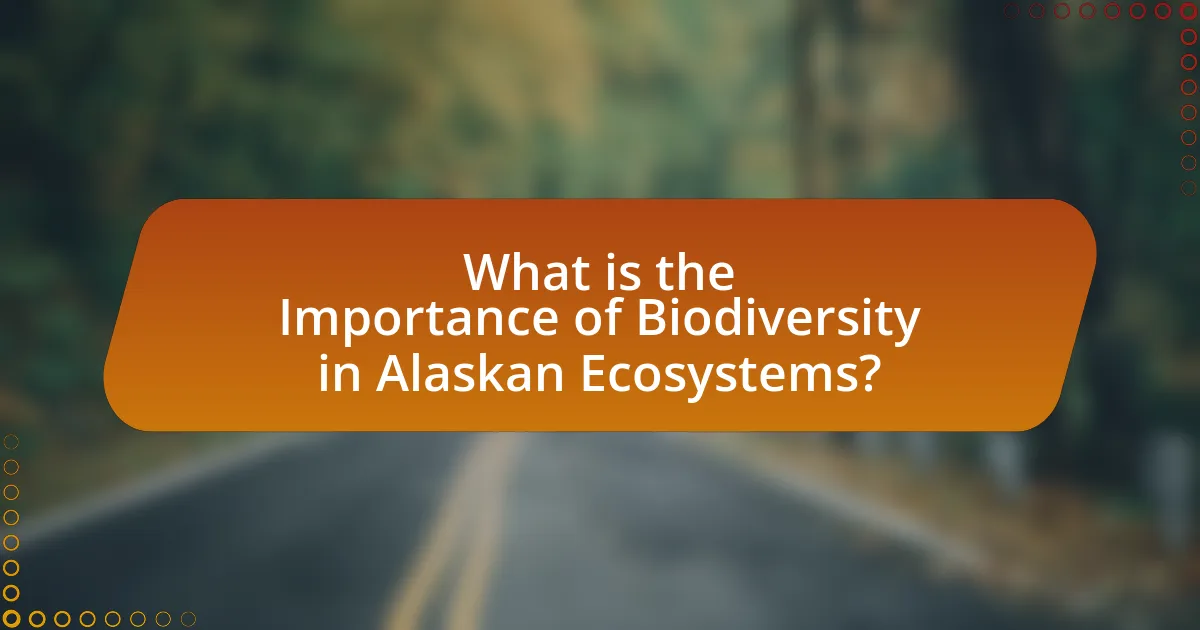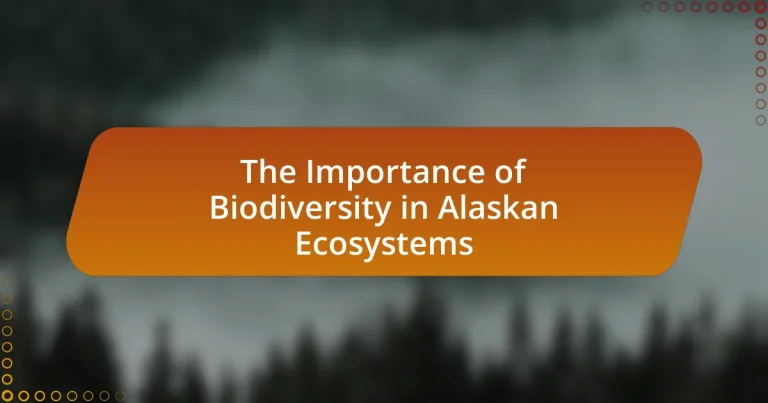Biodiversity in Alaskan ecosystems is essential for ecological balance, resilience, and the provision of vital ecosystem services. This article examines the significance of biodiversity in Alaska, highlighting its role in supporting species diversity, enhancing ecosystem health, and contributing to local economies through industries like fishing and tourism. It also addresses the threats posed by climate change, habitat loss, and invasive species, while emphasizing the importance of conservation efforts and community engagement in preserving Alaska’s unique biodiversity. Key components, such as keystone species and interdependent relationships between plants and animals, are discussed to illustrate the interconnectedness of biodiversity and ecosystem functionality.

What is the Importance of Biodiversity in Alaskan Ecosystems?
Biodiversity in Alaskan ecosystems is crucial for maintaining ecological balance and resilience. It supports a wide range of species, including unique flora and fauna that contribute to the region’s food webs and nutrient cycles. For instance, the presence of diverse species enhances ecosystem productivity and stability, allowing ecosystems to better withstand environmental changes such as climate fluctuations. Additionally, biodiversity provides essential services such as clean water, air purification, and carbon sequestration, which are vital for both wildlife and human populations. The richness of species in Alaska, including migratory birds and marine life, also supports local economies through tourism and fishing industries, highlighting the interconnectedness of biodiversity and human well-being.
Why is biodiversity crucial for ecosystem health in Alaska?
Biodiversity is crucial for ecosystem health in Alaska because it enhances resilience, stability, and productivity of ecosystems. Diverse species contribute to various ecological functions, such as nutrient cycling, pollination, and habitat provision, which are essential for maintaining ecosystem balance. For instance, the presence of a wide range of plant species supports diverse animal populations, which in turn helps in seed dispersal and pest control. Research indicates that ecosystems with higher biodiversity are better able to withstand environmental changes, such as climate fluctuations, which are particularly relevant in Alaska due to its rapidly changing climate. This interconnectedness underscores the importance of preserving biodiversity to ensure the long-term health and functionality of Alaskan ecosystems.
What roles do different species play in maintaining ecosystem balance?
Different species play crucial roles in maintaining ecosystem balance by contributing to various ecological functions such as nutrient cycling, pollination, and habitat structure. For instance, keystone species like sea otters in Alaskan ecosystems regulate sea urchin populations, which in turn helps maintain kelp forest health. Additionally, pollinators such as bees and birds facilitate plant reproduction, ensuring the survival of diverse plant species that provide food and habitat for other organisms. Furthermore, decomposers like fungi and bacteria break down organic matter, recycling nutrients back into the soil, which supports plant growth. These interdependent relationships illustrate how species diversity is essential for ecosystem stability and resilience, as evidenced by studies showing that ecosystems with higher biodiversity are more productive and better able to withstand environmental changes.
How does biodiversity contribute to resilience against environmental changes?
Biodiversity enhances resilience against environmental changes by providing a variety of species that can adapt to shifting conditions. This diversity ensures that ecosystems can maintain functionality and recover from disturbances, as different species fulfill various ecological roles. For instance, in Alaskan ecosystems, diverse plant and animal species contribute to nutrient cycling, habitat stability, and food web complexity, which are crucial for ecosystem health. Research indicates that ecosystems with higher biodiversity are better able to withstand stressors such as climate change, as demonstrated by studies showing that diverse coral reefs recover more quickly from bleaching events compared to less diverse ones.
What are the key components of biodiversity in Alaskan ecosystems?
The key components of biodiversity in Alaskan ecosystems include a wide variety of species, genetic diversity, and diverse habitats. Alaskan ecosystems host over 1,700 species of vascular plants, numerous animal species including mammals like moose and bears, and a rich array of marine life such as salmon and whales. Genetic diversity within these species is crucial for resilience against environmental changes and diseases. Additionally, the diverse habitats, ranging from tundra to forests and coastal areas, support this rich biodiversity, providing essential resources and ecological functions.
Which species are considered keystone species in Alaska?
Keystone species in Alaska include the sea otter, the gray wolf, and the Pacific salmon. These species play critical roles in maintaining the structure and function of their ecosystems. For instance, sea otters help control sea urchin populations, which in turn allows kelp forests to thrive, supporting diverse marine life. Gray wolves regulate moose populations, preventing overgrazing and promoting vegetation health. Pacific salmon contribute nutrients to freshwater and terrestrial ecosystems through their spawning activities, benefiting a wide range of species.
How do plant and animal diversity interact in these ecosystems?
Plant and animal diversity in Alaskan ecosystems interact through complex relationships that enhance ecosystem resilience and functionality. For instance, diverse plant species provide varied habitats and food sources for animals, which in turn contribute to seed dispersal and pollination, promoting further plant diversity. Research indicates that ecosystems with higher biodiversity are more productive and better able to withstand environmental stressors, such as climate change. A study published in the journal “Nature” by Cardinale et al. (2012) found that biodiversity loss can significantly reduce ecosystem services, highlighting the interdependence of plant and animal species in maintaining ecological balance.
What threats does biodiversity face in Alaskan ecosystems?
Biodiversity in Alaskan ecosystems faces significant threats primarily from climate change, habitat loss, and invasive species. Climate change leads to rising temperatures and altered precipitation patterns, which disrupt the delicate balance of these ecosystems. For instance, the melting of permafrost affects soil stability and releases greenhouse gases, further exacerbating climate issues. Habitat loss occurs due to industrial activities such as oil extraction and logging, which fragment and degrade natural habitats essential for various species. Invasive species, introduced through human activity, outcompete native species for resources, leading to declines in local biodiversity. These factors collectively threaten the ecological integrity and resilience of Alaskan ecosystems.
How do climate change and human activities impact biodiversity?
Climate change and human activities significantly reduce biodiversity by altering habitats and increasing species extinction rates. For instance, rising temperatures and changing precipitation patterns disrupt ecosystems, leading to habitat loss for many species. According to the Intergovernmental Panel on Climate Change (IPCC), approximately one million species are at risk of extinction due to climate change and human-induced factors such as deforestation, pollution, and urbanization. These activities not only degrade natural habitats but also introduce invasive species that outcompete native flora and fauna, further diminishing biodiversity.
What invasive species pose risks to native biodiversity in Alaska?
Invasive species that pose risks to native biodiversity in Alaska include the European green crab, the red fox, and the common reed (Phragmites australis). The European green crab threatens local shellfish populations and disrupts marine ecosystems, while the red fox preys on native bird species, particularly ground-nesting birds. The common reed outcompetes native vegetation, altering habitats and reducing biodiversity. These species have been documented in various studies, highlighting their detrimental impacts on Alaska’s unique ecosystems.

How does biodiversity affect the economy and culture of Alaska?
Biodiversity significantly impacts the economy and culture of Alaska by supporting industries such as fishing, tourism, and subsistence hunting. The state’s rich variety of species, including salmon and marine mammals, underpins commercial fishing, which contributes over $1.5 billion annually to Alaska’s economy. Additionally, biodiversity attracts tourists seeking to experience Alaska’s unique wildlife and natural beauty, generating approximately $2 billion in tourism revenue. Culturally, Indigenous communities rely on diverse ecosystems for traditional practices, food sources, and cultural identity, with subsistence hunting and gathering being integral to their way of life. Thus, the preservation of biodiversity is crucial for both economic sustainability and cultural heritage in Alaska.
What economic benefits arise from maintaining biodiversity in Alaska?
Maintaining biodiversity in Alaska provides significant economic benefits, including enhanced fisheries, tourism opportunities, and ecosystem services. The state’s diverse ecosystems support a robust fishing industry, which contributes over $1.5 billion annually to the economy, driven by species such as salmon and halibut. Additionally, Alaska’s rich biodiversity attracts millions of tourists each year, generating approximately $2 billion in tourism revenue, as visitors seek to experience its unique wildlife and natural landscapes. Furthermore, healthy ecosystems offer vital services such as carbon sequestration and water purification, which can lead to cost savings in environmental management and public health. These economic advantages underscore the importance of preserving biodiversity in Alaska.
How does biodiversity support industries such as tourism and fishing?
Biodiversity supports industries such as tourism and fishing by providing a rich variety of species that attract visitors and sustain fish populations. In Alaska, diverse ecosystems host unique wildlife, including whales, bears, and numerous bird species, which draw tourists for activities like wildlife viewing and photography. Additionally, healthy marine biodiversity ensures sustainable fish stocks, crucial for commercial fishing, as diverse species contribute to ecosystem resilience and productivity. For instance, the presence of various fish species helps maintain balanced food webs, which is essential for the long-term viability of fisheries.
What role does biodiversity play in traditional Alaskan cultures?
Biodiversity plays a crucial role in traditional Alaskan cultures by providing essential resources for subsistence, cultural practices, and spiritual beliefs. Indigenous communities rely on a diverse range of species, including fish, marine mammals, and terrestrial animals, for food, clothing, and tools, which are integral to their survival and way of life. For instance, the harvesting of salmon, a key species in Alaskan ecosystems, not only sustains diets but also supports cultural traditions and community gatherings. Furthermore, biodiversity contributes to the spiritual connection that many Alaskan Native groups have with the land and its creatures, as seen in their storytelling, rituals, and art, which often reflect the importance of various species. This interdependence highlights how biodiversity is not just a matter of ecological health but is deeply woven into the cultural fabric of Alaskan societies.
How can conservation efforts enhance biodiversity in Alaskan ecosystems?
Conservation efforts can enhance biodiversity in Alaskan ecosystems by protecting habitats, restoring degraded areas, and implementing sustainable resource management practices. For instance, the establishment of protected areas, such as national parks and wildlife refuges, safeguards critical habitats for various species, allowing populations to thrive. Additionally, initiatives aimed at restoring wetlands and forests contribute to the recovery of native species and the overall health of ecosystems. According to the U.S. Fish and Wildlife Service, these conservation strategies have led to increased populations of species like the Steller’s sea lion and the Arctic grayling, demonstrating the effectiveness of targeted efforts in promoting biodiversity.
What strategies are effective in protecting endangered species in Alaska?
Effective strategies for protecting endangered species in Alaska include habitat conservation, legal protections, and community engagement. Habitat conservation involves preserving critical ecosystems, such as wetlands and forests, which are essential for the survival of various species. Legal protections, such as the Endangered Species Act, provide a framework for the recovery of threatened species by regulating activities that may harm them. Community engagement fosters local stewardship and awareness, encouraging residents to participate in conservation efforts. These strategies are supported by data showing that protected areas in Alaska have led to population recoveries in species like the Steller sea lion and the polar bear, highlighting the effectiveness of these approaches.
How do protected areas contribute to biodiversity conservation?
Protected areas contribute to biodiversity conservation by providing habitats that protect species from habitat loss, overexploitation, and environmental degradation. These designated regions, such as national parks and wildlife reserves, serve as refuges for diverse flora and fauna, allowing ecosystems to thrive without the pressures of human activities. For instance, a study published in “Nature” by Watson et al. (2014) found that protected areas are crucial for preserving 80% of the world’s remaining biodiversity. By maintaining ecological integrity, these areas help sustain genetic diversity, promote ecosystem resilience, and support essential ecological processes.

What actions can individuals take to support biodiversity in Alaska?
Individuals can support biodiversity in Alaska by participating in local conservation efforts, such as habitat restoration projects and wildlife monitoring programs. Engaging in these activities helps protect native species and their habitats, which are crucial for maintaining ecological balance. For instance, organizations like the Alaska Conservation Foundation actively involve community members in initiatives that restore wetlands and forests, directly benefiting local wildlife. Additionally, individuals can reduce their ecological footprint by practicing sustainable living, such as minimizing waste and using eco-friendly products, which contributes to the overall health of Alaskan ecosystems.
How can local communities engage in biodiversity conservation?
Local communities can engage in biodiversity conservation by participating in habitat restoration projects, implementing sustainable land-use practices, and promoting local conservation initiatives. For instance, community-led efforts in Alaska have successfully restored salmon habitats, which are crucial for maintaining the region’s biodiversity. Additionally, local groups can advocate for policies that protect natural resources and educate residents about the importance of biodiversity, as seen in various Alaskan communities where educational programs have increased awareness and involvement in conservation efforts. These actions not only enhance local ecosystems but also foster a sense of stewardship among community members.
What practices can individuals adopt to reduce their ecological footprint?
Individuals can adopt several practices to reduce their ecological footprint, including minimizing energy consumption, reducing waste, and choosing sustainable transportation options. For instance, using energy-efficient appliances and switching to renewable energy sources can significantly lower household energy use, which accounts for a substantial portion of carbon emissions. Additionally, reducing waste through recycling and composting can decrease landfill contributions, as landfills are a major source of methane, a potent greenhouse gas. Opting for public transportation, biking, or walking instead of driving can further reduce carbon emissions associated with personal vehicles. According to the Environmental Protection Agency, transportation contributes approximately 29% of total greenhouse gas emissions in the United States, highlighting the impact of individual choices on ecological footprints.
What resources are available for learning more about Alaskan biodiversity?
Resources for learning about Alaskan biodiversity include the Alaska Department of Fish and Game, which provides extensive information on wildlife and ecosystems, and the University of Alaska Fairbanks, which offers research publications and educational programs focused on local biodiversity. Additionally, the National Park Service manages several parks in Alaska that feature educational materials and guided tours highlighting the region’s unique species and habitats. The Alaska Natural Heritage Program also offers databases and reports on species distribution and conservation efforts, making it a valuable resource for researchers and the public alike.
Where can one find educational programs focused on biodiversity in Alaska?
Educational programs focused on biodiversity in Alaska can be found through institutions such as the University of Alaska, which offers courses and research opportunities in environmental science and ecology. Additionally, organizations like the Alaska Sea Grant and the Alaska Wildlife Conservation Center provide workshops and educational resources aimed at promoting biodiversity awareness. These programs are designed to enhance understanding of Alaska’s unique ecosystems and the importance of biodiversity conservation.
What organizations are dedicated to the conservation of Alaskan ecosystems?
Organizations dedicated to the conservation of Alaskan ecosystems include the Alaska Conservation Foundation, The Nature Conservancy in Alaska, and the Alaska Wildlife Conservation Center. The Alaska Conservation Foundation focuses on protecting Alaska’s natural environment through grants and advocacy, while The Nature Conservancy works on land and water conservation projects to preserve biodiversity. The Alaska Wildlife Conservation Center is dedicated to the rehabilitation of injured animals and the education of the public about wildlife conservation. These organizations actively engage in initiatives that support the preservation of Alaska’s unique ecosystems and biodiversity.
What are some best practices for promoting biodiversity in everyday life?
To promote biodiversity in everyday life, individuals can adopt practices such as planting native species, reducing pesticide use, and supporting local conservation efforts. Planting native species helps create habitats that support local wildlife, as these plants are adapted to the local environment and provide food and shelter for native animals. Reducing pesticide use minimizes harmful impacts on non-target species, including beneficial insects and pollinators, which are crucial for ecosystem health. Supporting local conservation efforts, such as participating in community clean-up events or donating to wildlife organizations, contributes to the protection and restoration of natural habitats. These practices collectively enhance biodiversity and contribute to the resilience of ecosystems, including those in Alaska, where diverse species play vital roles in maintaining ecological balance.


